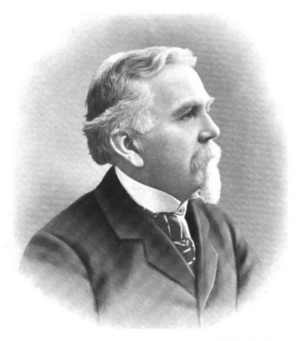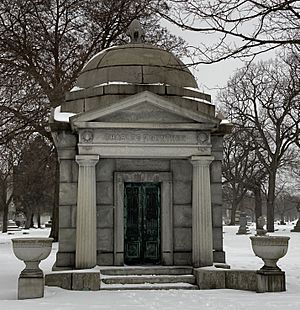Charles F. Gunther facts for kids
Quick facts for kids
Charles F. Gunther
|
|
|---|---|
 |
|
| Chicago Alderman from 2nd Ward | |
| In office 1896–1900 Serving with Martin Best (1896–1897)
Patrick J. Cook (1897–1899) Eugene R. Pike (1899–1900) |
|
| Preceded by | Addison Ballard |
| Succeeded by | William Hale Thompson |
| Personal details | |
| Born | March 6, 1837 |
| Died | February 10, 1920 (aged 82) Chicago, Illinois |
| Resting place | Rosehill Cemetery |
| Occupation | Confectioner |
Charles Frederick Gunther (born March 6, 1837, died February 10, 1920) was a German-American who became a rich candy maker. He was also a politician and loved collecting old and interesting things. Many items he collected are now at the Chicago History Museum. He even served as a Chicago alderman (a city council member) for two terms.
Contents
Charles Gunther's Early Life
Charles Gunther's family moved from Germany to Pennsylvania in 1842. Later, they settled in Peru, Illinois. In 1860, Gunther traveled south and got a job with an ice company in Memphis, Tennessee.
When the American Civil War began, Gunther helped transport Confederate soldiers. Union troops captured him in 1862. He was soon released and went back to Illinois. During the war, he worked as a traveling salesman. He sold candy from a Chicago company, mostly in the southern states.
Candy Business and Amazing Collections
After the Civil War, Gunther went to Europe. He wanted to learn from the best candy makers there. In 1868, he started his own candy company in Chicago. He was famous for his caramel, and some say he brought it to the United States.
The Great Chicago Fire in 1871 destroyed Gunther's business. But he quickly rebuilt a new factory on State Street. Rich customers, like socialite Bertha Palmer, helped him make a lot of money. With his wealth, Gunther started buying historical items. He displayed these items in his factory.
Collecting Unique Historical Items
Many items in his collection were from the Civil War. But he also had very unusual things, like shrunken heads. Gunther even claimed to own the skin of the serpent from the Garden of Eden. He also said he had the mummy of Moses' foster mother, Bithiah. Most people believe these were fake.
One of Gunther's most important real items was Abraham Lincoln's deathbed. He bought it in 1877. His collection grew so large that he decided to buy the Libby Prison. This was a former Confederate prison in Richmond, Virginia.
Libby Prison Museum
Gunther bought the prison building. He had it taken apart and shipped to Chicago. There, it was put back together and became a museum for his artifacts. The museum opened in 1889. Thousands of people visited it in the first few months.
The prison's infirmary (sick room) became the Lincoln Room. Here, Gunther displayed Lincoln's deathbed. He also showed other items connected to Lincoln's assassination. Later, Gunther tried to buy an Egyptian pyramid. He also tried to buy Philadelphia's Independence Hall. He wanted to bring them to Chicago, but he was not successful.
Collection's Future
In the 1890s, Gunther became involved in Chicago's growing convention business. The original Chicago Coliseum burned down in 1897. Gunther decided to build a new Coliseum where the Libby Prison museum stood. Attendance at the museum was starting to decline.
The prison building was taken apart again. Some parts were given to the Chicago Historical Society. Gunther offered the rest of his collection to the city. He hoped the city would build a museum for it in Garfield Park. However, Illinois law prevented building on parkland.
Gunther's Collection Today

Charles Gunther died at his home in Chicago on February 10, 1920. After his death, the Chicago Historical Society paid $150,000 for most of his collection. By then, the collection also included the table where Robert E. Lee surrendered at Appomattox Court House.
Soon after, the society began building a new museum. It cost $1 million to display their expanded collection. The building opened in 1932. It is now known as the Chicago History Museum.
One small item in Gunther's huge collection was an alleged "skin of the serpent" from the Garden of Eden. It was even framed! The museum staff believes the skin might be from a real anaconda or python. But they know it did not come from the Garden of Eden. The hieroglyphic markings on its frame are just gibberish.

